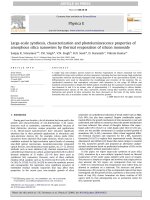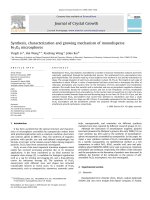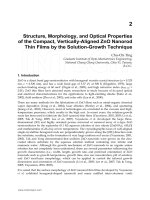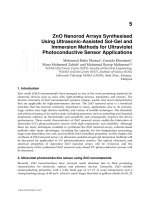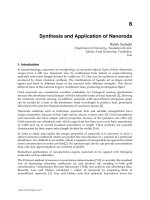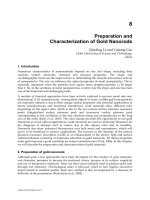Synthesis, characterization and potential applications of pyrene based organic materials
Bạn đang xem bản rút gọn của tài liệu. Xem và tải ngay bản đầy đủ của tài liệu tại đây (5.6 MB, 256 trang )
SYNTHESIS, CHARACTERIZATION AND POTENTIAL
APPLICATIONS OF PYRENE BASED ORGANIC
MATERIALS
JHINUK GUPTA
NATIONAL UNIVERSITY OF SINGAPORE
2010
SYNTHESIS, CHARACTERIZATION AND POTENTIAL
APPLICATIONS OF PYRENE BASED ORGANIC
MATERIALS
JHINUK GUPTA
(M. Sc., Indian Institute of Technology Madras, India)
A THESIS SUBMITTED
FOR THE DEGREE OF DOCTOR OF PHILOSOPHY
DEPARTMENT OF CHEMISTRY
NATIONAL UNIVERSITY OF SINGAPORE
2010
SYNTHESIS, CHARACTERIZATION AND POTENTIAL
APPLICATIONS OF PYRENE BASED ORGANIC MATERIALS
Abstract
Fluorescent pyrene derivatives have found applications in various fields of science
including organic electronics, sensors and conformational studies. However, the need for
systematic research and product development of pyrene derivatives still remains. The aim
of this thesis was to gain insight about structure-property relationship of pyrene
derivatives by synthesizing a series of small molecules and polymers and to use them for
different applications. Structurally versatile side arms, shape of polymer backbone and
location of the pyrene units on the polymer chain have been explored as the contributing
parameters toward physical properties of the target compounds such as electronic
conjugation, thermal stability, self-assembly, crystal packing and surface topology. Some
of the key findings showed significant enhancement of conjugation upon successive
introduction of acetylene units in the side arms of small molecules and by incorporation
of pyrene on the polymer backbone. Kinked backbone was found to be more conjugated
as compared to the linear analogue. It was possible to form self-assembled nanostructures
with regular shape and size via introducing amphiphilicity to the derivatives.
The synthesized compounds with thioacetate and hydroxyl binding groups were
successfully employed for the removal of silver and gold nanoparticles from water with
quantitative extraction efficiencies. Higher radical quenching efficiency of the
synthesized pyrene–pyrogallol derivatives as compared to natural antioxidants such as
vitamin-C indicates their potential use as fluorescent antioxidants.
Keywords: pyrene, fluorescence, conjugated polymers, self-assembly, nanoparticles,
phase transfer, fluorescent antioxidant.
i
A
A
C
C
K
K
N
N
O
O
W
W
L
L
E
E
D
D
G
G
E
E
M
M
E
E
N
N
T
T
S
S
It is my great pleasure to acknowledge the following individuals whose contributions
went beyond the mere scientific aspects of this work.
I would like to express my gratitude to my supervisor, Associate Prof. Suresh
Valiyaveettil, for his guidance, support and patience during the course of this work.
My sincere thanks to Prof. S. Sankararaman of Indian Institute of Technology, Madras
for his support and blessings.
I thank all the past and present members of our lab who made this journey enjoyable. I
thank Dr. Ani Deepthy, Dr. Santosh, Dr. Sivamurugan, Dr. Gayathri, Dr. Nurmawati, Dr.
Hairong, Dr. Haiyu, Dr. Fathima, Dr. Satyananda, Mr. Ankur, Mr. Narahari, Mr. Yiwei, Mr.
Kirubakaran, Ms. Chunyan, Mr. Ashok and Mr. Ramakrishna. Special thanks to Mrs. Sajini for
her immense help in microscopic techniques besides being a wonderful friend. I thank Mr.
Pradipta and Mr. Tanay for being such adorable juniors who helped me in every possible ways.
I take this opportunity to thank the undergraduate students Mr. Swee Meng, Mr. Siu Kee,
Ms. Junyi and Mr. Wei Jun for their help in this work.
I acknowledge the technical assistance provided by all staff members in the CMMAC.
All my friends deserve special thanks for bringing joy into my life. Special thanks to Ms.
Amrita for making my stay memorable in Singapore. Thanks to Mr. Mir and Mr. Goutam for
helping me with the single crystal XRD.
Finally, I would like to express my gratitude towards my parents, grandmother and my
husband. This thesis would not come to the reality without their tolerance, continuous support and
encouragement.
ii
Table of Contents
Acknowledgements
i
Table of Contents
ii
Summary
x
Abbreviations and Symbols
xiii
List of Tables
xvii
List of Figures
xix
List of Schemes
xxiv
Chapter 1. Introduction
1.1.
Pyrene: The Smallest Peri- Fused Polycyclic
Aromatic Hydrocarbon
2
1.2.
Physical Properties of Pyrene
3
1.2.1. Optical Properties 3
1.2.2. Solvatochromism 4
1.2.3. Electrochemical Properties 5
1.3.
Reactive Sites of Pyrene
6
1.4.
Functionalization of Pyrene
7
1.4.1. Electrophilic Substitution 7
1.4.1.1. Halogenation 9
1.4.1.2. Nitration 10
1.4.1.3. Acylation 11
iii
1.4.1.4. Alkylation 11
1.4.2. Nucleophilic Substitution 11
1.4.3. Reduction 12
1.4.4. Oxidation 13
1.5. Pyrene Polymers
13
1.5.1. Polymers with Pendant Pyrene Moieties 14
1.5.2. Polymers with Pyrene End-cap 16
1.5.3. Polymers with Pyrene Incorporated Backbone 16
1.5.4.
Comparison Between Different Types of Pyrene
Polymers
17
1.6. Applications of Pyrene Derivatives
18
1.6.1. Applications in Organic Electronics 19
1.6.1.1. Pyrene Based LCDs 19
1.6.1.2. Pyrene Based OLEDs 20
1.6.1.3. Pyrene Based OFETs 20
1.6.1.4. Pyrene Based Organic Solar Cells 21
1.6.2. Sensors 21
1.6.3. Pyrene Based Biomolecular Probes 22
1.6.4. Conformational study of macromolecules,
supramolecules and micelle
23
1.6.4.1. Investigation of Polymer Chain Dynamics 23
1.6.4.2. Conformational Study of Supramolecules 24
1.6.4.3. Study of Micelle 24
1.6.5. Miscelleneous use
25
iv
1.6.5.1. Associative Thickeners (ATs) 25
1.6.5.2. Study of Surrounding Polarity 26
1.7.
NPs, Nanotoxicity and Available Methods for
Nanowaste Management
26
1.7.1. NPs and Nanotoxicity 26
1.7.2. Available Methods for Nanowaste Management 27
1.8.
Phase Transfer of NPs
28
1.8.1. Replacement of the Original Ligands 29
1.8.2. Encapsulation of the NPs with Differently
Charged Ligands
30
1.8.3. Chemical Modification of the Original Ligands 30
1.9.
Chromophore-NP Interaction
31
1.9.1. Pyrene-NP Interaction 32
1.10.
Antioxidants
33
1.10.1. Fluorescent Antioxidants 34
1.11.
Aim and Purpose of the Thesis
36
1.12.
References
38
Chapter 2. Synthesis and Property Studies of Pyrene–
Thiophene Derivatives
2.1. Introduction
64
2.2. Experimental Section
66
2.2.1. Materials and Methods 66
2.2.2. Synthesis 68
v
2.3. Results and Discussion
74
2.3.1. Synthesis and Characterization 74
2.3.2. Crystal Structures 75
2.3.3. Thermal Properties 81
2.3.4. Optical Properties 82
2.3.5. Electrochemical Properties 85
2.3.6. Surface Morphology 87
2.4. Conclusion
88
2.5.
References
89
Chapter 3. Synthesis and Property Studies of Linear and
Kinked Poly(pyreneethynylene)s
3.1. Introduction
94
3.2. Experimental Section
96
3.2.1. Materials and Methods 96
3.2.2. Synthesis 98
3.2.2.1. General Synthetic Procedure for Sonogashira
Polymerization
101
3.2.2.2. Synthesis of Compound 2 102
3.2.2.3. General Synthetic Procedure for Sonogashira
Coupling Reaction
103
3.3. Results
105
3.3.1. Synthesis and Characterization 105
3.3.2. Thermal Properties 107
vi
3.3.3. Optical Properties 109
3.3.4. Electrochemical Properties 111
3.3.5. Self-assembly 113
3.4. Discussion
114
3.5. Conclusion
117
3.6. References
118
Chapter 4. Design and Synthesis of Pyrene-Thioacetate
Derivatives Suitable for Nanowaste Treatment
4.1. Introduction
123
4.2. Experimental Section
126
4.2.1. Materials and Methods 126
4.2.2. Synthesis 127
4.2.2.1. General Method for Polymerization 132
4.2.3. Synthesis of Au and Ag NPs 134
4.2.4. Synthesis of electrospun PVA NF 135
4.2.5. General Protocol for Liquid Phase Extraction of
NPs
135
4.2.6. General Protocol for Extraction Using Polymer
Coated PVA NF
136
4.3. Results and Discussion
136
4.3.1. Synthesis and Characterization 136
4.3.2. Thermal Properties 139
4.3.3. Optical Properties 140
vii
4.3.4. Electrochemical Properties 144
4.3.5. Extraction of NPs 145
4.3.5.1. Extraction of NPs Using TM6 and TM7 146
4.3.5.2. Extraction of NPs Using Target Polymers
(POLY7 – POLY9)
146
4.3.5.2.1. Liquid Phase Extraction 146
4.3.5.2.2. Extraction Using Polymer Coated Electrospun
PVA NF
152
4.4. Conclusion
153
4.5. References
154
Chapter 5. Synthesis of Fluorescent Amphiphilic Polymers
Suitable for Nanowaste Removal
5.1.
Introduction
160
5.2.
Experimental Section
161
5.2.1. Materials and Methods 161
5.2.2. Synthesis 162
5.2.2.1. General Synthetic Procedure for O-alkylation 164
5.2.2.2. General Synthetic Procedure for Bromination 166
5.2.2.3. General Synthetic Procedure for Sonogashira
Coupling Reaction
167
5.2.2.4. General Synthetic Procedure for Desilylation 169
5.2.2.5. General Synthetic Procedure for Polymerization 171
5.2.2.6. General Synthetic Procedure for Hydrolysis of
Solketal Group
172
viii
5.2.3. General Protocol for Liquid Phase Extraction of
NPs
174
5.2.4. General Protocol for Extraction Using Polymer
Coated PVA NF
174
5.3. Results and Discussion
175
5.3.1. Synthesis and Characterization 175
5.3.2. Thermal Properties 178
5.3.3. Optical Properties 180
5.3.4. Electrochemical Properties 183
5.3.5. Self-assembly 185
5.3.6. Extraction of NPs 187
5.3.6.1. Liquid Phase Extraction 187
5.3.6.2. Extraction Using Polymer Coated PVA NF 192
5.4. Conclusion
194
5.5. References
195
Chapter 6. Synthesis of Pyrene Based Fluorescent Antioxidants
6.1. Introduction
200
6.2. Experimental Section
201
6.2.1. Materials and Methods 201
6.2.2. Synthesis 203
6.2.2.1. General protocol for debenzylation 208
6.3. Results and Discussion
209
ix
6.3.1. Synthesis and Characterization 209
6.3.2. Optical Properties 211
6.3.3. Electrochemical Properties 215
6.3.4. Self-assembly 218
6.3.5. Antioxidant Property 219
6.4. Conclusion
221
6.5. References
221
Chapter 7. Conclusion and Future Prospects
Conclusion and Future Prospects
225
x
Summary
Fluorescent compounds are important due to their wide spread applications in all
fields of science, ranging from biology to material science. Pyrene is one of the
interesting fluorophores with high quantum efficiency, ease of functionalization and
π
-
stacking ability. The focus of this thesis is aimed towards the design, synthesis and
characterization of structurally versatile pyrene based fluorescent conjugated systems.
Both polymers and small molecules have been explored. Small molecules are based on
mono-, di- and tetra- substituted pyrene whereas, the polymers contain either pendant
pyrene units or pyrene incorporated backbone. The effect of structure has been
investigated on the optical, electrochemical, thermal and self-assembly behavior of the
synthesized compounds. Studies were extended to demonstrate the utility of some of the
synthesized compounds in specific applications such as nanowaste removal from water.
A brief introduction about pyrene and its derivatives has been given in Chapter
one, which includes physical properties, reactivity, functionalization and applications.
Besides, the concepts of nanoparticles (NPs), nanotoxicity, NP-chromophore interaction
and fluorescent antioxidant compounds have been explained.
Chapter two elucidates the synthesis of a series of pyrene–thiophene derivatives
with varying spacers and the investigations about their optoelectronic properties and
surface topologies. Single crystal structures of the synthesized derivatives are reported. It
is found that introduction of increasing number of acetylene units as spacer results in
lower band gap, higher fluorescence quantum yield and more negative E
HOMO
at the cost
of thermal stability and film forming property.
xi
The interesting results obtained with acetylene spacer in Chapter two, motivated
to develop linear and bent poly(pyreneethynylene)s in Chapter three. Significant
influence of shape of polymer backbone was found on the physical properties of the
polymers. Kinked backbone of cisoid- polymers appeared to contribute towards lower
bandgap, less negative E
HOMO
and higher thermal stability as compared to the linear
transoid- analogues. A plausible explanation for such behavior has been hypothesized
with the formation of coil and rod structures by cisoid- and transoid- polymers,
respectively.
Recent findings about nanotoxicity triggered the design and synthesis of
molecules and polymers capable of extracting toxic NPs from aqueous environment.
Fluorescent compounds are advantageous because, the quenching of fluorescence
intensity upon binding to the NPs can be used to monitor the extraction process. Chapter
four of the thesis describes design and synthesis of pyrene based hydrophobic,
fluorescent compounds with thioacetate binding groups followed by optimization of the
extraction set-up using citrate capped hydrophilic Au and Ag NPs. Polymers and small
molecules with rigid and flexible side arms were synthesized for the purpose which
extract NPs by ligand exchange mechanism. Extraction efficiency of the polymers was
found to be quantitative (∼ 99 %) as compared to the small molecules.
In order to reduce the extraction time of NPs, pyrene based amphiphilic polymers
have been synthesized in Chapter five. Hydroxyl groups on the side chain of the
polymers induce amphiphilicity and ensure binding to NPs. Higher number of hydroxyl
groups on polymer resulted in improved extraction efficiency. Overall extraction time
reduced to half of that required for pyrene–thioacetate systems.
xii
Fluorescent antioxidants have generated interests owing to the added advantage of
monitoring the radical quenching process and sensing the location of ROS production.
Chapter six deals with the synthesis and characterization of pyrene based fluorescent
antioxidants containing pyrogallol as receptor. IC
50
values of the synthesized compounds
were found to be exciting which is even lower than that of some of the naturally
occurring antioxidants such as vitamin-C.
A summary of the overall results obtained is given in Chapter seven with some
aspects of the future prospects.
xiii
ABBREVIATIONS AND SYMBOLS
Å Angstrom(s)
AgNP Silver Nanoparticle
AFM Atomic Force Microscopy
AuNP Gold Nanoparticle
bs Broad Singlet
bm Broad Multiplate
13
C NMR Carbon Nuclear Magnetic Resonance
CDCl
3
Deuterochloroform-d
CV Cyclic Voltammetry
Conc. Cincentrated
DCB 1,2-Dichlorobenzene
DCM Dichloromethane
DMF
N, N
′
- Dimethylformamide
DMSO Dimethyl Sulfoxide
DMSO-d
6
Deuterated Dimethyl Sulfoxide
DSC Differential Scanning Calorimetry
EDX Energy-Dispersive X-ray
EI-MS Electron Impact Mass Spectrum
ESI-MS Electron Spray Ionization Mass Spectrum
FAB-MS Fast Atom Bombardment Mass Spectrometry
xiv
FT-IR Infrared Fourier Transform
g Gram(s)
GPC Gel Permeation Chromatography
h Hour(s)
HCl Hydrochloric acid
1
H NMR Proton Nuclear Magnetic Resonance
H-bond Hydrogen Bond
HOMO Highest Occupied Molecular Orbital
Hz Hertz
ICP-OES Inductively Coupled Plasma Optical Emission Spectrometry
i.e. That is (Latin id est)
ITO Indium Tin Oxide
J
Coupling Constant
LD
50
Lethal Dose, 50%
LUMO Lowest Unoccupied Molecular Orbital
m Multiplate
MALDI-TOF MS Matrix Assisted Laser Desorption/Ionization – Time of Flight
Mass Spectrometry
MeOH Methanol
mg Milligram(s)
ml Milliliter(s)
mmol millimol
m/z
Mass/Charge
xv
MWCNT Multi-walled Carbon Nanotube
NBS N-Bromo Succinamide
NP Nanoparticle
NF Nanofiber
NMR Nuclear Magnetic Resonance
PDI Poly Dispersity Index
POLY Polymer
ppm Parts per Million
PVA Poly(vinyl alcohol)
q Quartet
QD Quantum Dot
rms Root Mean Square
ROS Reactive Oxidant Species
rt Room Temperature
s Singlet
SEM Scanning Electron Microscope
t Triplet
T
d
Decomposition Temperature
T
g
Glass Transition Temperature
TEM Transmission Electron Microscope
TGA Thermo Gravimetric Analysis
THF Tetrahydrofuran
TLC Thin Layer Chromatography
xvi
TM Target Molecule
TMS Tetra Methyl Silane (NMR standard)
TMSA Tri Methyl Silyl Acetylene
UV-Vis Ultra-Violet Visible Spectroscopy
XRD X-Ray Diffraction
δ
Chemical Shift (in NMR Spectroscopy)
ν
Infrared Stretching Frequency
xvii
LIST OF TABLES
Table No. Title of the Table Page
No.
Chapter 1
Table 1.1 List of reported fluorescent probes for ROS detection 35
Chapter 2
Table 2.1 Crystallographic data for TM1, TM2 and TM3 76
Table 2.2 Optical properties of TM1 – TM3 84
Table 2.3 Electrochemical properties of TM1 – TM3 87
Chapter 3
Table 3.1 Molecular weight and TGA data of target compounds
(POLY1 – POLY6 and TM4 – TM5)
106
Table 3.2 Optical properties of target compounds (POLY1 – POLY6
and TM4 – TM5)
115
Table 3.3 Electrochemical properties of target compounds (POLY1 –
POLY6 and TM4 – TM5)
116
Chapter 4
Table 4.1 GPC and TGA data of the target compounds (TM6 – TM7
and POLY7 – POLY9)
138
Table 4.2 Optical properties of the target compounds (TM6 – TM7
and POLY7 – POLY9).
143
Table 4.3 Electrochemical properties of target compounds (TM6 –
TM7 and POLY7 – POLY9)
145
Table 4.4 Extraction efficiency of the target compounds (TM6 – TM7
and POLY7 – POLY9) for Au and Ag NPs
158
Table 4.5 Zeta potentials of NPs before and after extraction 151
xviii
Chapter 5
Table 5.1 GPC and TGA data of the polymers (POLY10 – POLY15) 176
Table 5.2 Determination of ratio of two repeating units present in the
polymers (POLY10 – POLY15)
177
Table 5.3 Optical properties of the polymers (POLY10 – POLY15) 183
Table 5.4 Electrochemical properties of the polymers (POLY10 –
POLY15)
185
Table 5.5 Extraction efficiency of the polymers (POLY13 – POLY15)
for Au and Ag NPs
188
Table 5.6 Zeta potentials of NPs before and after extraction 191
Chapter 6
Table 6.1 Optical properties of the target compounds (TM8 – TM11) 213
Table 6.2 Effect of acid and base on optical properties of TM9 and
TM11
215
Table 6.3 Electrochemical properties of target compounds (TM8 –
TM11)
217
xix
LIST OF FIGURES
Figure No. Title of the Figure Page
No.
Chapter 1
Figure 1.1 Molecular structure of pyrene along with numbering scheme 2
Figure 1.2 Functionalization at various reactive sites of pyrene ring 6
Figure 1.3
Possible resonance structures of the
σ
- complexes formed at C
1
,
C
2
and C
4
positions of pyrene
8
Figure 1.4 Mono-, di- and tetra- functionalization of pyrene at 1,3,6,8-
positions using electrophilic substitution
9
Figure 1.5 Schematic representation of different types of pyrene polymers 14
Figure 1.6 Various fields of applications of pyrene derivatives 18
Figure 1.7 Various methods of phase transfer of NPs between water and
organic medium
29
Figure 1.8 Mechanism of enhancement and quenching of pyrene fluorescence
in contact with NPs
33
Chapter 2
Figure 2.1 Molecular structure of the target compounds (TM1 – TM3) 65
Figure 2.2 Crystal structure of TM1. (a) Molecular structure viewed
approximately along b axis, carbon - grey, hydrogen – white and
sulfur – yellow. (b) The packing structure and relative orientations
of the molecules viewed approximately along b axis
77
Figure 2.3 Crystal structure of TM2. (a) Molecular structure viewed along c
axis, carbon - grey, hydrogen – white and sulfur – yellow. (b)
Packing along c axis viewed from ab plane
79
Figure 2.4 Crystal structure of TM3. (a) Molecular structure viewed along c
axis, carbon - grey, hydrogen – white and sulfur – yellow. (b)
Molecular packing along c axis viewed from ac plane
80
Figure 2.5
TGA thermograms of TM1 (○), TM2 (◊), TM3 (☆)
81
xx
Figure 2.6
Absorption (a, c) and emission (b, d) spectra of pyrene (-), TM1
(○), TM2 (◊), TM3 (☆) in chloroform (10
-5
M, 28 °C) (a, b) and
dropcasted film (c, d)
83
Figure 2.7
Cyclic voltammograms of TM1 (
○), TM2 (◊), TM3 (☆)
86
Figure 2.8 AFM images of spincoated films of TM1. (a) DCB, 30 °C (b)
DCB, 70 °C (c) chloroform, 30 °C (d) chloroform, 70 °C
88
Chapter 3
Figure 3.1 Structure of the target compounds (POLY1 – POLY6 and TM4 –
TM5)
96
Figure 3.2 Thermograms of polymers (a) and model compounds (b). POLY1
(
▲) POLY2 (∆) POLY3 (■) POLY4 (□) POLY5 (●) POLY6 (○)
TM4 (★) TM5 (☆). DSC traces of (c) TM4 and (d) TM5.
Polarized optical microscope images of compound TM4 recorded
during cooling (e) 85 °C (f) 63 °C (g) 31 °C
108
Figure 3.3 Absorption (a, c) and emission (b, d) spectra of the polymers in
DCM (0.1 mg/mL, 28 °C) (a, b) and thin film (c, d). POLY1 (▲)
POLY2 (∆) POLY3 (■) POLY4 (□) POLY5 (●) POLY6 (○)
109
Figure 3.4 Absorption (a, c) and emission (b, d) spectra of model compound
TM4 (▼) and TM5 (▽) in DCM (10
-5
M, 28 °C) (a, b) and thin
film (c, d)
110
Figure 3.5 Cyclic voltammograms of (a) POLY1 (▲) and POLY2 (∆), (b)
POLY3 (■) and POLY4 (□), (c) POLY5 (●) and POLY6 (○), (d)
TM4 (
★) and TM5 (☆)
112
Figure 3.6 SEM image of POLY1 (a) POLY3 (c), POLY5 (d) and AFM
image of POLY1 (b) showed coiled fiber self-assembly of the
cisoid- polymers
113
Chapter 4
Figure 4.1 Structure of the target compounds (TM6 – TM7 and POLY7 –
POLY9)
124
Figure 4.2
Thermograms of TM6 (●), TM7 (○), POLY7(
☆), POLY8 (□),
POLY9 (-)
140
xxi
Figure 4.3 Absorption (a, c) and emission (b, d) spectra of TM6 (○) and TM7
(●) in chloroform (10
-5
M, 28 °C) (a, b) and thin film (c, d)
141
Figure 4.4 Absorption (a, c) and emission (b, d) spectra of the polymers in
chloroform (0.2 mg/mL, 28 °C) (a, b) and thin film (c, d). Pyrene
(-), POLY7 (
☆), POLY8 (○), POLY9 (★)
142
Figure 4.5
Cyclic voltammograms of TM6 (
○), TM7 (●), POLY7 (★),
POLY8 (-) and POLY9 (☆)
144
Figure 4.6 Absorption spectra of aqueous layer of (a) Ag and (b) Au NPs
before extraction (1) and after extraction with TM6 (2), TM7 (3),
POLY9 (4), POLY7 (5) and POLY8 (6)
147
Figure 4.7 (a) Pictorial representation of the vials after extraction. Vials 1 and
2 contain AgNP, vials 3 and 4 contain AuNP. Extraction of the NP
solution in presence of POLY7 resulted in complete transfer of
AgNP (vial 2) and AuNP (vial 4) from water (top) to DCM
(bottom) layer. Shaking of the NP solutions with DCM alone did
not result any phase transfer of NPs (vial 1 and 3). (b)
Fluorescence spectra of the DCM layer of vial 2 (○) and vial 4 (●)
showed quenching of fluorescence intensity as compared to the
DCM solution of POLY7 before extraction (★). TEM images of
the dropcasted film of DCM layer of vial 2 (c) and vial 4 (d)
confirm transfer of AgNP and AuNP from water to DCM layer.
Insets show the TEM images of the corresponding NPs before
extraction
149
Figure 4.8 Zeta potential distribution of citrate capped AuNP (a) citrate
capped AgNP (b) POLY7 capped AuNP (c) POLY7 capped
AgNP (d) and only POLY7 (e)
150
Figure 4.9 IR spectra of (a) Ag and (b) Au NPs before and after extraction 151
Figure 4.10 Absorption spectra of water layer before and after removal of (a)
Ag and (b) Au NPs. (★) NP solution before extraction, (☆) NP
solution after extraction with POLY7 coated PVA NF, (○) NP
solution after extraction with POLY8 coated PVA NF. SEM
images of POLY7 coated PVA NF after extraction show
attachment of (c) AgNP and (d) AuNP onto the fiber. Insets show
SEM images of the corresponding PVA NF before extraction
153
xxii
Chapter 5
Figure 5.1 Molecular structures of the target polymers (POLY13 – POLY15) 161
Figure 5.2
Thermograms of POLY10 (●), POLY11 (★), POLY12 (▲),
POLY13 (○), POLY14 (☆) and POLY15 (∆)
179
Figure 5.3
Absorption (a, c) and emission (b, d) spectra of pyrene (-),
POLY10 (○), POLY11 (☆) and POLY12 (∆) in chloroform (0.2
mg/mL, 28 °C) (a, b) and thin film (c, d)
180
Figure 5.4 Absorption (a, c) and emission (b, d) spectra of POLY13 (○),
POLY14 (☆) and POLY15 (∆) in chloroform (0.2 mg/mL, 28 °C)
(a, b) and thin film (c, d)
182
Figure 5.5 Cyclic voltammograms of POLY10 (○), POLY11 (∆), POLY12
(☆), POLY13 (★), POLY14 (-) and POLY15 (◊)
184
Figure 5.6 SEM (a, c, e) and TEM (b, d, f) micrographs of self-assembled
structure of POLY13 (a, b), POLY14 (c, d) and POLY15 (e, f)
obtained from a mixture of THF/water (5:1, v/v)
186
Figure 5.7 Absorption spectra of aqueous layer of (a) Ag and (b) Au NPs
before extraction (★) and after extraction with POLY13 (∆),
POLY14 (○) and POLY15 (☆)
188
Figure 5.8 (a) Pictorial representation of the vials after extraction. Vials 1 and
2 contain AgNP, vials 3 and 4 contain AuNP. Extraction of the NP
solution in presence of POLY13 resulted in complete transfer of
AgNP (vial 2) and AuNP (vial 4) from water (top) to DCM
(bottom) layer. Shaking of the NP solutions with DCM alone did
not result any phase transfer of NPs (vial 1 and 3). (b)
Fluorescence spectra of the DCM layer of vial 2 (○) and vial 4 (●)
showed quenching of fluorescence intensity as compared to the
DCM solution of POLY13 before extraction (★). TEM images of
the dropcasted film of DCM layer of vial 2 (c) and vial 4 (d)
confirm transfer of AgNP and AuNP from water to DCM layer.
Insets show the TEM images of corresponding NPs before
extraction
189
Figure 5.9 Zeta potential distribution of citrate capped AuNP (a) citrate
capped AgNP (b) POLY13 capped AuNP (c) POLY13capped
AgNP (d) and only POLY13 (e).
191
Figure 5.10 IR spectra of (a) Ag and (b) Au NPs before and after extraction 192
